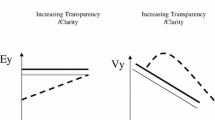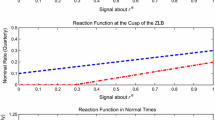Abstract
The paper examines different aspects of transparency. Transparency serves democratic accountability by promoting public control. Specifically, the degree of transparency conditions inflation expectations, hence the central bank's scope for stabilization. Recent studies have put doubt on the notion that complete transparency is socially desirable. Here it is pointed out that the conclusion critically depends on an asymmetric modelling of stochastic preferences. The paper also reviews the pros and cons of revealing individual voting. A conclusion is that secrecy is to be prefered in monetary unions in order to shield governors from pressure by home governments.
Similar content being viewed by others
References
Bank of England, Monetary Policy Committee: Various issues.
Barro, R. J.; Gordon, D. “A Positive Theory of Monetary Policy in a Natural Rate Model,”Journal of Political Economy, 91, 1983, pp. 589–610.
Beetsma, R. M. W. J.; Jensen, H. “Inflation Targets and Contracts with Uncertain Central Banker Preferences,”Journal of Money, Credit and Banking, 30, 3.1, 1998, pp. 384–403.
Bini Smaghi, L. “The Democratic Accountability of the European Central Bank,”Banca Nazionale del Lavoro Quarterly Review, 51, 1998, pp. 119–43.
Blinder, A. S. “What Central Bankers Could Learn from Academics and Vice Versa,”Journal of Economic Perspectives, 11, 1997, pp. 3–20.
Briault, C.; Haldane, A.; King, M. “Independence and Accountability,” in: I. Kuroda (ed.),Towards More Effective Monetary Policy, London: Macmillan, 1997, pp. 299–326.
Brunner, K. “The Art of Central Banking, Centre for Research in Government Policy and Business,” Working Paper Gp B, 1981, pp. 81–6.
Buiter, W. H. “Alice in Euroland,”Journal of Common Market Studies, 37, 2, 1999, pp. 181–209.
Cukierman, A.; Meltzer, A. “A Theory of Ambiguity, Credibility and Inflation under Discretion and Asymmetric Information,”Econometrica, 54, 1986, pp. 1099–128.
Eijfinger, S. C. W.; Hoebrichts, M.; Schaling, E. “Why Money Talks and Wealth Whispers: Monetary Uncertainty and Mystique,”Journal of Money, Credit and Banking, 32, 2, 2000, pp. 218–35.
Federal Reserve Bulletin: Various issues.
Faust, J.; Svensson, L. E. O. “Transparency and Credibility: Monetary Policy with Unobserved Goals,”International Economic Review, 42, 1999, pp. 369–97.
——. “The Equilibrium Degree of Transparency and Control in Monetary Policy,”Journal of Money, Credit and Banking, 34, 2002, pp. 520–39.
Goodfriend, M. “Monetary Mystique: Secrecy and Central Banking,”Journal of Monetary Economics, 17, 1986, pp. 63–92.
Herrendorf, B.; Neumann, M. J. M. “The Political Economy of Inflation, Labour Market Distortions and Central Bank Independence,” CEPR Discussion Paper 1969, 1998.
--. “The Political Economy of Inflation, Labour Market Distortions and Central Bank Independence,”Economic Journal, 2002 (forthcoming).
Issing, O. “The Eurosystem: Transparent and Accountable or Willem in Euroland,”Journal of Common Market Studies, 37, 3, 1999, pp. 503–19.
Lohmann, S. “Optimal Commitment in Monetary Policy: Credibility versus Flexibility,”American Economic Review, 82, 1992, pp. 273–86.
Mihov, I.; Sibert, A. “Credibility and Flexibility with Monetary Policy Committees,” mimeo, London, 2002.
Sørensen, J. R. “Political Uncertainty and Macroeconomic Performance,”Economic Letters, 37, 1991, pp. 377–81.
Stuart, A.; Ord, J. K.Kendall's Advanced Theory of Statistics, Vol. 2, 5th ed., London: Eduard Arnold, 1991.
Waller, C. J. “Monetary Policy Games and Central Bank Politics,”Journal of Money, Credit and Banking, 21, 4, 1989, pp. 422–31.
Winkler, B. “Which Kind of Transparency? On the Need for Clarity in Monetary Policy-Making,” European Central Bank Working Paper 26, 2000.
Author information
Authors and Affiliations
Rights and permissions
About this article
Cite this article
Neumann, M.J.M. Transparency in monetary policy. Atlantic Economic Journal 30, 353–365 (2002). https://doi.org/10.1007/BF02298778
Issue Date:
DOI: https://doi.org/10.1007/BF02298778




